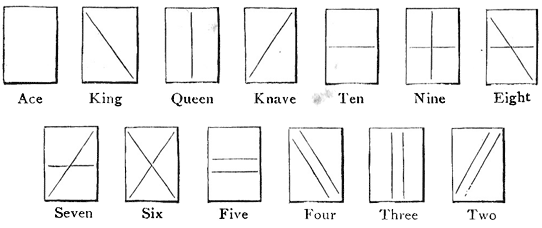
|
foreword to the online edition I. introductory II. common sharpers and their tricks III. marked cards and the manner of their employment IV. reflectors V. holdouts VI. manipulation VIII. the game of faro IX. prepared cards X. dice XI. high ball poker XII. roulette and allied games XIII. sporting houses XIV. sharps and flats
|
SHARPS AND FLATS
CHAPTER III MARKED CARDS AND THE MANNER OF THEIR EMPLOYMENT
§ B -- The marking of unprinted backsIt might very naturally be supposed, that the application of any system of marking to the backs of those cards which are of an even tint, without pattern, would be a very difficult operation. Such, however, is by no means the case. One might think that any mark, however slight, placed upon the plain white back of a 'club-card,' must inevitably be discovered sooner or later. Such an idea, nevertheless, would indicate a very scant acquaintance with the resources which are available to the cardsharper. One of the earliest methods of marking of which there is any record was used in connection with this class of card. The incident is related by Houdin, whose account of the matter is to the following effect. A card-sharper having been detected in cheating, a great quantity of cards were found in his possession. The authorities, thinking that there might possibly be some preparation or falsification of them, sent them to Houdin for examination. To all appearance, however, the cards were perfectly genuine. He could detect nothing amiss with them. But notwithstanding the negative result of his investigation, he felt morally certain that they must have been tampered with in some way. He therefore persevered in his efforts to solve the problem, but several weeks elapsed, and still he found himself exactly in the position from which he started. At length, disgusted by such prolonged and repeated failure, he flung a pack of the cards carelessly across the table at which he was sitting. Then, in an instant, the long-sought revelation was presented to his view. The cards were marked, and in a manner sufficiently ingenious to arouse the investigator's enthusiasm at the time, although the method employed might not be thought so very high class nowadays. We have advanced since then. The cards in question were of the ordinary glazed kind, and lying at some little distance upon the table the light from the window was reflected from their backs. This circumstance disclosed the fact that each one had a small unglazed spot upon it, placed in such a position as to indicate the suit and value. Fig. 4 will explain the system at a glance. The glaze is removed by the simple expedient of putting a drop of water upon the required spot, and blotting it off after a few seconds. Such a mark is quite invisible under ordinary circumstances, but when the cards are held at a suitable angle to the light, the unglazed spot is readily apparent. This, of course, is not the only method of producing the desired effect. Sometimes the glaze is removed by means of a sharp knife. Another plan is to produce a shallow concavity at the proper position by laying the card upon its face and pressing upon it with the rounded end of a penholder or some similar and convenient instrument. In fact, anything which will cause a little variation in the reflection of the light from the back of the card will suffice. The cards above referred to were merely 'picquet' packs. Therefore there was nothing lower than the 'seven.' If it is necessary to mark a full pack, the lower cards may be marked with two dots, as shown in fig. 4. When unglazed, or 'steamboat' cards were in general use, a very efficient mode of marking was devised. It was done by ruling lines on the backs with a piece of paraffin wax. Fig. 3 shows the arrangement.
FIG. 3 -- Unglazed Cards This method is of course the converse of the foregoing, the object of using the wax being to impart a glaze where none previously existed. As before, these marks are only decipherable when the cards are held at a proper angle. Cards marked as in fig. 3 would answer perfectly for a game such as 'poker,' where the suit is of no consequence. If it is required to give both suit and value, another mark a dot for example could be added, the position of which would give the necessary indication. The ace, it will be observed, is not marked. In most systems, either the ace or the two is indicated by the absence of marking. The same thing applies to the suits, it is only required to mark three out of the four.
|
| « marked cards... (general principles...) | marked cards... (...dot and puncture) » |
home | introduction | book content | links | advertising | contact
